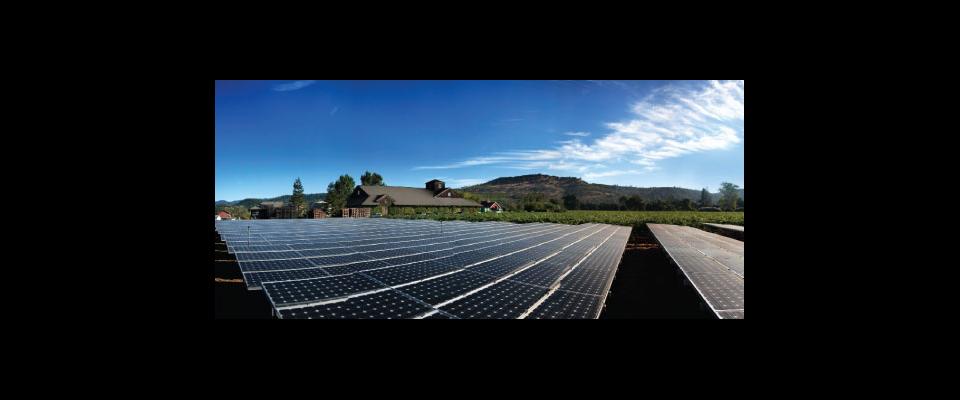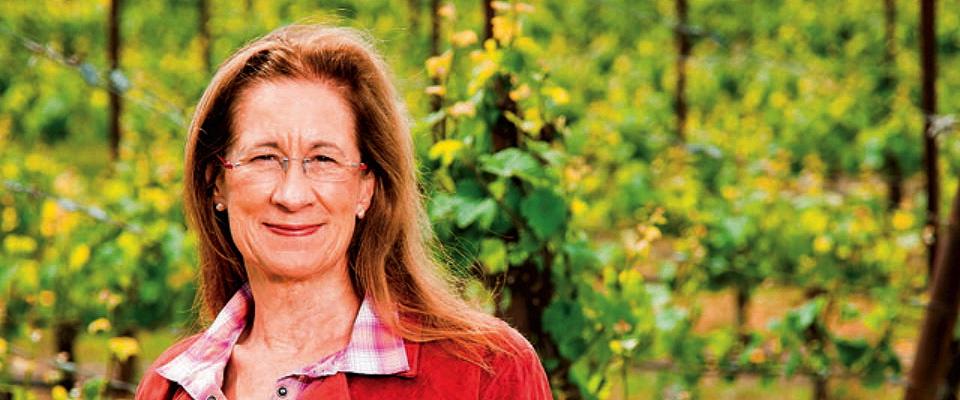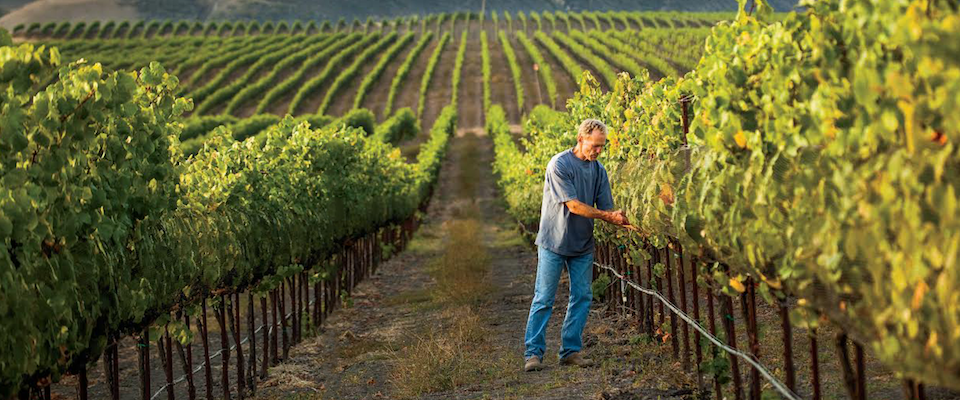California’s wine industry proclaims it’s leading the way toward sustainability. But are winemakers going green—or dry—enough to make a difference?
California winemaking is big, big business. Two out of three bottles consumed in the U.S. are California wines. Those 196 million cases had retail sales of $18.5 billion in 2008; close to another $1 billion’s worth went to export. The state is the world’s No. 4 wine producer behind France, Italy, and Spain.
Like any business, it’s under a lot of pressure from external forces. In California the winemaking industry has been largely self-regulating. Members of Wine Institute and the California Association of Winegrape Growers started the Sustainable Winegrowing Program (SWP) in 2002, and the nonprofit California Sustainable Winegrowing Alliance (CSWA) a year later. The current chair of the alliance is Chris Savage, director of global environmental affairs for E. & J. Gallo, the largest winemaker in the United States and the second largest in the world. The SWP defines “sustainable winegrowing” as employing practices that hit the sweet spot of a Venn diagram labeled Environmentally Sound, Economically Feasible, and Socially Equitable.
With substantial financial backing from the U.S. Department of Agriculture, the CSWA has codified into a 500-page tome its best practices in 14 areas ranging from air quality to winery water conservation. With detailed self-assessment worksheets and workshops all over the state, the alliance reports that more than 71 percent of grape growers and 60 percent of winemakers participated in the SWP in some manner in 2008. Meanwhile, the words “sustainable” and “green” have bloomed all over California winery websites and annual reports.
At least one prominent academic isn’t impressed. “Millions of dollars from USDA have gone into administering this program, and what do they have to show for it? A few handbooks and a few workshops,” says Roger Boulton, an Australian contrarian and the Stephen Sinclair Scott Endowed Chair in Enology at UC Davis’s Department of Viticulture and Enology. “Show me site-specific indices for carbon, water, energy, and chemistry, or even one winery that knows, let alone tells, what its footprints are in any of these areas. There’s a conspicuous lack of metrics compared to the rest of the world, and I don’t think its accidental. The SWP is less about sustainability than self-interest.”
Certainly, the wine industry prefers to advertise its more photogenic measures—miniature sheep that keep weeds down, solar panels amid the grapes—rather than hard data on its water and energy usage. But to hear winemakers tell it, it is in their self-interest to become ever more sustainable, and they are seeking better means to measure their progress. John Williams, who holds a master’s degree from the Davis program and is the founder of Frog’s Leap winery, says, “It’s about enlightened self-interest that happens to produce bigger dividends. It would be great if everybody else thought that way. Is there more Frog’s Leap could be doing to be sustainable? Yes. Lots. But we also have to be sustainable as a business. And there are always trade-offs of some kind.”
There remains a tension between true sustainability—in simplest terms, the ability of an ecosystem to renew itself—and measures that simply allow a winery to stay in business for a few more decades.
Crop per drop
The primary concern for both the grape-growing and wine-bottling sides in California is water. As humans, fish, and agriculture compete for water supplies that are dwindling in both quantity and quality, the cost of water and the energy needed to deliver it both rise. In fall 2008, for example, the Westlands Water District slashed allocations to growers in the South San Joaquin Valley: The price of additional water, usually $95 per acre-foot (enough to cover an acre one foot deep), reportedly spiked to $500. Vineyards were parched; harvests, low.
And things are likely to get worse. “We’re pushing ourselves to the brink of supply, and agriculture is definitely feeling the pinch,” says Carolyn Remick, executive director of the Berkeley Water Center, an interdisciplinary research center. “Surface allocations are likely to get more expensive. In the past, grape growers have just been able to go underground, but now there are serious discussions happening about whether it might be necessary to regulate groundwater supplies in the future. There is a lot of pressure on the industry to conserve.”
Agriculture is already California’s biggest water hog, and the wine industry takes two turns gulping at the trough: in the fields and in the winery. (Many, though not all, California wineries grow their own grapes.) More than three-quarters of California’s 9.5 million acres of cropland are irrigated. Only a small percentage of that total is devoted to growing wine grapes, but 526,000 acres is a significant chunk of soil. “Wine grapes are by far not one of the egregious water-wasters,” says Berkeley’s Remick. That honor falls to rice, cotton, and alfalfa, which, she adds, “there might be smarter places to grow” than California. Grapes use less water than rice or tomatoes, but they are as thirsty a crop as other tree fruits, and depending on where the vineyard is located, they can be very thirsty indeed.
A December 2008 USDA-funded report from the California Sustainable Winegrowing Alliance, targeted at grape growers, estimates that California coastal vineyards average about 2–4 inches of irrigation water per acre, while those in the Central Valley range from 18 to 30 acre-inches. Central Valley vineyards, where about 60 percent of California wine grapes are grown, tend to require more irrigation because of the more demanding climate. Additionally, they face economic pressure to squeeze more grapes per acre, since they command a fraction of the prices per ton that the more famous Napa region can.
The report, “Reducing Risks Through Sustainable Winegrowing,” gives specific goals for reducing acre-inch usage in excess of the average, and outlines measures that will help do so. For the most part, wasteful overhead irrigation sprinklers are already long gone, replaced by drip irrigation and technologically targeted irrigation.
All of the irrigation at Talley Vineyards on the South Central Coast, for example, is on a monitored drip system. “We have devices in the vineyards that tell us the exact soil moisture, so we only water when we need to,” says Talley president Brian Talley ’88. He’s concerned about conserving water for its own sake, but he’s more concerned about pests and weeds that thrive in moist environments. That and leaf mold, because Talley’s vineyards are in a much damper climate than Napa’s.
Frog’s Leap in Napa, meanwhile, doesn’t irrigate its 200 acres at all. Instead Williams uses a technique called “dry farming.” This, he says firmly, is “not about ‘not watering’; it’s about creating an ecosystem that simply needs less water.” Frog’s Leap estimates that dry-farming its vineyards saves a minimum of 16,000 gallons per acre, compared with Napa growers who lightly irrigate.
Out in the vineyards, Williams picks up a shovel and digs deep into the dusty soil. Sure enough, about 8 inches down, a darker moisture is visible. This depth is intentional, encouraging the vines’ roots to go deep, where weeds can’t. The top layer of “dust mulch” conserves the soil moisture while a system of careful but constant tillage allows that moisture to wick up from below.
Dry-farmed vineyards are found almost exclusively in Napa, among small boutique wineries, because these vineyards have much lower yields: The vines have to be planted farther apart and produce smaller, more intensely flavored fruit. That makes them challenging from a cost-effective standpoint for growers outside of Napa, like Talley, who can’t command as high a price for their grapes. When California starts rationing water for agriculture—and most observers believe it’s a question of when, not if—that equation may change, as it has for drought-plagued Australia.
Water to wine
The second big gulp that the wine industry takes at California’s water trough happens out of sight, in the wineries. Although no water actually goes into wine, copious quantities are used to wash grapes, sterilize tanks, and rinse out barrels. No reliable figures exist for the average amount of water needed to produce a gallon of wine on the winery side. The SWP workbook references an industry average of 7 gallons per case, which translates to 2.9 gallons of water per gallon of wine, an estimate based on North Coast conservation goals. A higher figure of 6:1 is often bandied about, but it has no clear source; it appears to be based more on Napa’s municipal water-use code than on actual measurements. Others put the range from 2 to 16 gallons of water per gallon of wine. Water usage rates differ, too: Larger wineries have larger tanks, for example, which can be washed more efficiently.
Even a leader like Honig Vineyard & Winery doesn’t know how much water it uses. Michael Honig (grandson of founder Louis Honig ’33) helped develop the SWP code and remains on the CSWA board; his medium-size winery issues a Green Report Card on itself every year. The Honig operation is as much a model of sustainability as Frog’s Leap: minimal, super-high-tech irrigation; solar power; cover crops—Honig has even put thousands into a program to train and deploy dogs that can sniff out the grape pest mealybugs.
The Honig property draws its water from various wells, and “we’re working on putting meters on all our buildings,” says Honig’s winemaker, Kristin Belair, another Davis grad. Belair thinks the winery has already cut its water usage in half by switching to pressurized steam for cleaning and using sanitation testing technology to minimize unnecessary cleanings.
Adam Love, M.S. ’98, Ph.D. ’02, founded a microwinery called Two Mile Wines in 2006 with a group of friends, including two other Cal alums. Since it began, Two Mile has bought grapes grown sustainably and locally, and even shared the cost with one supplier of converting 2.12 acres of sangiovese grapes to be certified organic. As an environmental engineer, Love is “definitely conscientious about water use” at Two Mile’s small Berkeley bottling plant. They dry-sweep instead of hosing down outside spaces, reuse water to clean equipment, and use a pressure washer rather than a hose where appropriate. But when it comes to stats on the total water usage, Love too comes up dry.
Actual industry figures may be on the way. In mid-October, the CSWA received a three-year, $590,000 grant from the federal government to develop industrywide metrics, baselines, and online support tools to measure winegrowing sustainability. “We recognize the need for quantitative information, too,” wrote Allison Jordan, director of environmental affairs at the Wine Institute, in an email confirming the just-signed grant. “It’s difficult to get accurate figures, or even to know if people are comparing apples to apples.”
Some of the state’s wineries have published their water usage numbers, but they are definitely the exception, and if anything they underline the need for industry baselines. Fetzer Vineyards along California’s North Coast is the state’s largest grower of organic grapes, producing nearly 4 million cases of wine per year. It says its water-saving strategies have reduced consumption to 2.1 gallons for every gallon of wine, versus what it says is the industry average of 8:1. Trinchero Family Estates, a large winery that owns the Sutter Home brand and others, claims a truly impressive 1.5:1 ratio; all of its winery wastewater is treated and goes back to its fields. That’s not practical for smaller wineries—storing the water can be expensive, and winemaking happens several months after the vines need the water, as Honig’s Belair points out.
And anyway, “that’s not recycling,” sniffs the hard-to-please Boulton. In drought-parched Australia, where the billion-dollar wine industry has had to cope with intense scrutiny of its water practices, he says that when winemakers discuss sustainability it’s not about “how much water do you use—although they can all tell you—it’s how many times did you use it. Using your water three times means using one-third less water.” But even cutting-edge conservationists such as Fetzer don’t recycle their winery water internally.
Growing power
Water is the most immediate stressor, but long-term sustainability also requires reduced reliance on nonrenewable energy sources. Finding alternatives to electricity to power irrigation pumps and wineries; to ever-pricier synthetic fertilizers (which are derived from fossil fuels and contribute to greenhouse gases); and to truck-powered, fuel-inefficient distribution chains would both cut costs and help shrink the state’s carbon footprint.
As with water, the most visible strides in energy conservation have been made in the fields. The majority of vineyards now plant cover crops such as nitrogen-rich legumes and grasses between the vines, which get tilled into the soil to replace or supplement synthetic nitrogen. Cover crops are also part of integrated pest-management plans, which seek to replace broad-spectrum chemical pesticides with less harmful, more sustainable methods.
At Fetzer and Honig and a few dozen other wineries, rows of photovoltaic panels shine in between the vines. Frog’s Leap has 1,020 photovoltaic panels that provide 80 percent of the winery’s power over the year, and was the first in Napa to gain LEED certification for its hospitality center. But none of these solar installations can fully power operations, even outside the energy-intensive crush and bottling periods. Wineries, like any food processing factory, require a lot of power: for cooling and cold storage, to heat water for cleaning barrels and equipment, and to warm red wine ferments and yeast generator tanks.
Williams of Frog’s Leap says he installed the solar panels simply to better fix his energy expenses for future years. “We’re not doing this stuff to save the Earth,” he says, although his visible obsession with the living soil beneath his vineyards somewhat belies this.
Bottleneck
Most of the debate over bottles has focused on their material—lightweight plastic or Tetra Pak versus glass, whether heavy or lightweight or partially recycled. Honig winery uses lightweight, recycled-glass bottles to reduce shipping costs, and has “long internal debates,” according to Michael Honig, over whether to use plastic or tin foils for the tops. (Turns out the locally made plastic tops were more sustainable than the faraway-mined tin.)
But there’s a little-known fact about wine bottles that calls into question just how seriously to take the CSWA: Wine bottles are exempt from California’s bottle deposit law. And it’s because the wine industry (like the liquor industry) successfully fought for an exclusion in 1986 when the bill passed. As a result, less than a third of the more than 600 million wine and liquor bottles produced in California are recycled, according to the environmental research group Californians Against Waste.
Wine Institute spokesperson Gladys Horiuchi says that the bottle bill was originally developed to prevent littering, and “it was never felt that wine bottles were a part of that problem.” The wine industry is instead advocating for more curbside recycling programs in rural areas. Small wineries support the effort to close that loophole; however, certain very large ones are still fighting it behind the scenes.
It’s not hard to see an economic motive for resistance: Manufacturers must pay a few pennies per bottle to offset recyclers’ costs. That doesn’t affect wineries that buy their bottles, but could pinch the profits of Gallo, which also owns its own huge bottle-making plant, Gallo Glass, headquartered in Modesto. Coincidentally, Gallo Glass was served in December 2008 with a cease-and-desist notice and a $73,000 fine from the State Water Resources Control Board for illegally diverting Russian River water into an unauthorized reservoir on its 395-acre vineyard near Healdsburg. (A Gallo spokesperson, when asked for comment on the bottle bill and the Russian River fine, instead offered a list of Gallo Glass’s sustainable practices: Gallo Glass uses 29 percent of all California’s recycled glass, recycles 95 percent of its water, and is currently developing what it says will be the nation’s most lightweight wine bottle.)
“Most of this is just paper decorations for what Gallo does and doesn’t want to have,” Boulton says. “Show me the winery whose annual report doesn’t say that they’re organic or biodynamic or sustainable, but that does list kilowatt hour or liter of water per liter of wine.”
One winery is about to. Boulton and a team at UC Davis are in the middle of building a teaching winery that he says will set the standard for sustainable winemaking in the United States. The new Research and Teaching Winery has broken ground and will be operational in September 2010. The first LEED platinum winery, it will rely on captured rainwater from the roof of a nearby academic building and use all of its water five times, Boulton boasts. The building will be fully solar powered even at peak daytime load, entirely off the grid—and once they have the money for fuel cell storage, at night, too. The winery will capture and sequester all the carbon dioxide from its fermentation processes.
Alas, you won’t be able to buy UC Davis’s supergreen wine. It’s a teaching winery only, making small batches for student and faculty research. The bad ones will go to the campus biodigester. “The good stuff we’ll drink,” says Boulton.




















